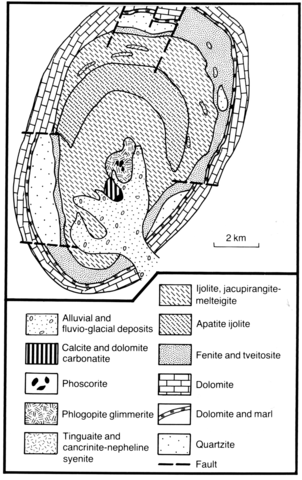stripes
Magan is the largest intrusion in the southern part of the province and is situated on the watershed of the Magan and Diogzho Rivers. It was discovered in 1954 and at different times scientific investigations have been carried out by, amongst others, G.G. Moor, L.S. Egorov, E.L. Butakova, Yu.A. Bagdasarov and S.M. Kravchenko. The country rocks are Riphean carbonate rocks of the Kotuikan suites underlying which are quartz sandstones of the Mukun series. The latter are metamorphosed at contacts with the intrusion and transformed into apatite-bearing rocks of the aegirine fenite series. The Magan intrusion has an irregular oval form, which is elongated in a north-south direction and an area of over 50 km2. The massif is composed of a series of intrusive and metamorphic\metasomatic rocks namely jacupirangite, melteigite, jacupirangite-melteigite metasomatic rocks, ijolite, phlogopite-bearing ijolite pegmatite and micro-ijolite, nepheline and cancrinite syenites, rocks of the phoscorite series, including magnetite rock, ore forsteritite and phoscorite, dolomite-calcite and dolomite carbonatites. The olivinites are found as small altered phlogopitized xenoliths among the nepheline-pyroxene rocks and contain olivine and titanomagnetite as the main minerals with clinopyroxene, perovskite, phlogopite, clinohumite, spinel, chromite and calcite as accessories. The rock-forming minerals of the jacupirangite and melteigite are clinopyroxene (up to 90%), nepheline, biotite, titanomagnetite, titanite and perovskite; the minor constituents are olivine, aegirine-augite, apatite, melanite, K-feldspar, phlogopite, zeolites, calcite, cancrinite and tremolite. The ijolites, which comprise more than half of the area of the complex, contain areas of olivinite and jacupirangite. The ijolites contain up to 60% nepheline and up to 50% pyroxene as the main minerals. Titanomagnetite, biotite-phlogopite and melanite are present in minor amounts and accessory minerals are perovskite, titanite, apatite, zeolites and calcite. In many localities the ijolites are cut by veins of phlogopite-bearing ijolite pegmatite and by later dykes of micro-ijolite. Arcuate and lens-like bodies of cancrinite-nepheline syenite are controlled by ring faults in the northern half of the complex. The youngest rocks of the complex are concentrated in the central southern part where the centre is occupied by a 1 km-diameter stock-like body of dolomite carbonatite, which on its northern margin borders a body of similar size of magnetite rocks and phoscorites composed of forsterite, apatite and carbonate. South of the stock the jacupirangites, melteigites and ijolites are cut by a series of steeply dipping veins of pegmatitic ore forsteritites. There is no extensive rare element mineralization in the carbonatites but analytical data for rare elements in a range of rock types are given by Bagdasarov (1987).
*BAGDASAROV, Yu.A. 1987. Geologic and geochemical features of the apatite-iron-ore rocks and the carbonatites of the Magan pluton. International Geology Review,29: 264-80.
BOGADITSA, V.P., BRAGINA, V.I., GERDT, A.A., DANILIN, K.L., EGOROV, L.S., KAZITSKY, M.L., KOROLEV, E.M., MALISHEV, A.A., MATUKHINA, V.G., MKRTCHYAN, A.K., RUSAKOV, D.K., SERGEEV, V.L., SHALMINA, G.G. and SHERMAN, M.L. 1983. Y.N. Zanin (ed) The apatite deposits of the Maimecha-Kotui province and their geological and economic assessment. Siberian Branch of the Academy of Sciences, Novosibirsk. 83 pp.
EGOROV, L.S. 1960. On the problem of nephelinization and iron magnesium-calcium metasomatism in intrusive alkaline and ultrabsic rocks. Trudy Nauchno-Issledovatel'skogo Instituta Geologii Arktiki, Leningrad, 114: 1102-8.
EGOROV, L.S. 1968. Apatite of the Maimecha-Kotui complex of ultrasbasic alkaline rocks. In D. Vorobyeva and V Petrov (eds), Apatite, 227-32. Nauka, Moscow.
EGOROV, L.S. 1980. The rocks of the phoscorite series (apatite-magnetite ores) of the Essei massif and some general problems of petrology, classification and nomenclature of apatite-olivine-magnetite rocks of ijolite-carbonatite complexes. In L.S. Egorov (ed) Alkaline magmatism and apatite-bearing rocks of the north of Siberia. 39-60. Trudy Nauchno-Issledovatel'skogo Instituta Geologii Arktiki, Leningrad.
EGOROV, L.S. 1991. Ijolite carbonatite plutonism (case history of the Maimecha-Kotui complexes northern Siberia). Nedra, Leningrad. 260 pp.
GOLDBURT, T.L. and LANDA E.A. 1963. A new phlogopite deposit Magan at the north of the Siberian platform. Uchenye Zapiski Nauchno-Issledovatel'skogo Instituta Geologii Arktiki, Leningrad, 1: 35-43.
KRAVCHENKO, S.M. and BAGDASAROV, Yu.A. 1987. Geochemistry, mineralogy and origin of the apatite-bearing massifs (Meimecha-Kotui carbonatite province. Nauka, Moscow. 128 pp.
MOOR, G.G. 1957. The differentiated alkaline intrusives of the northern margin of the Siberian Platform (the right bank of the lower stream of the Kotui river). Izvestiya Akademii Nauk SSSR, Seriya Geologicheskaya, 8: 400-52.

